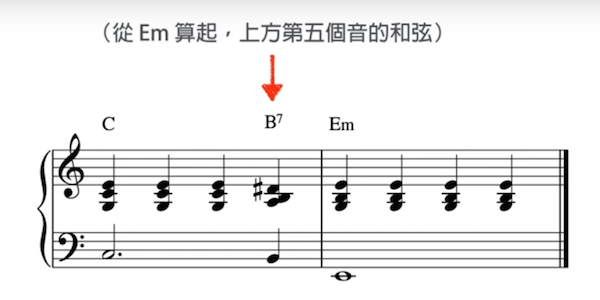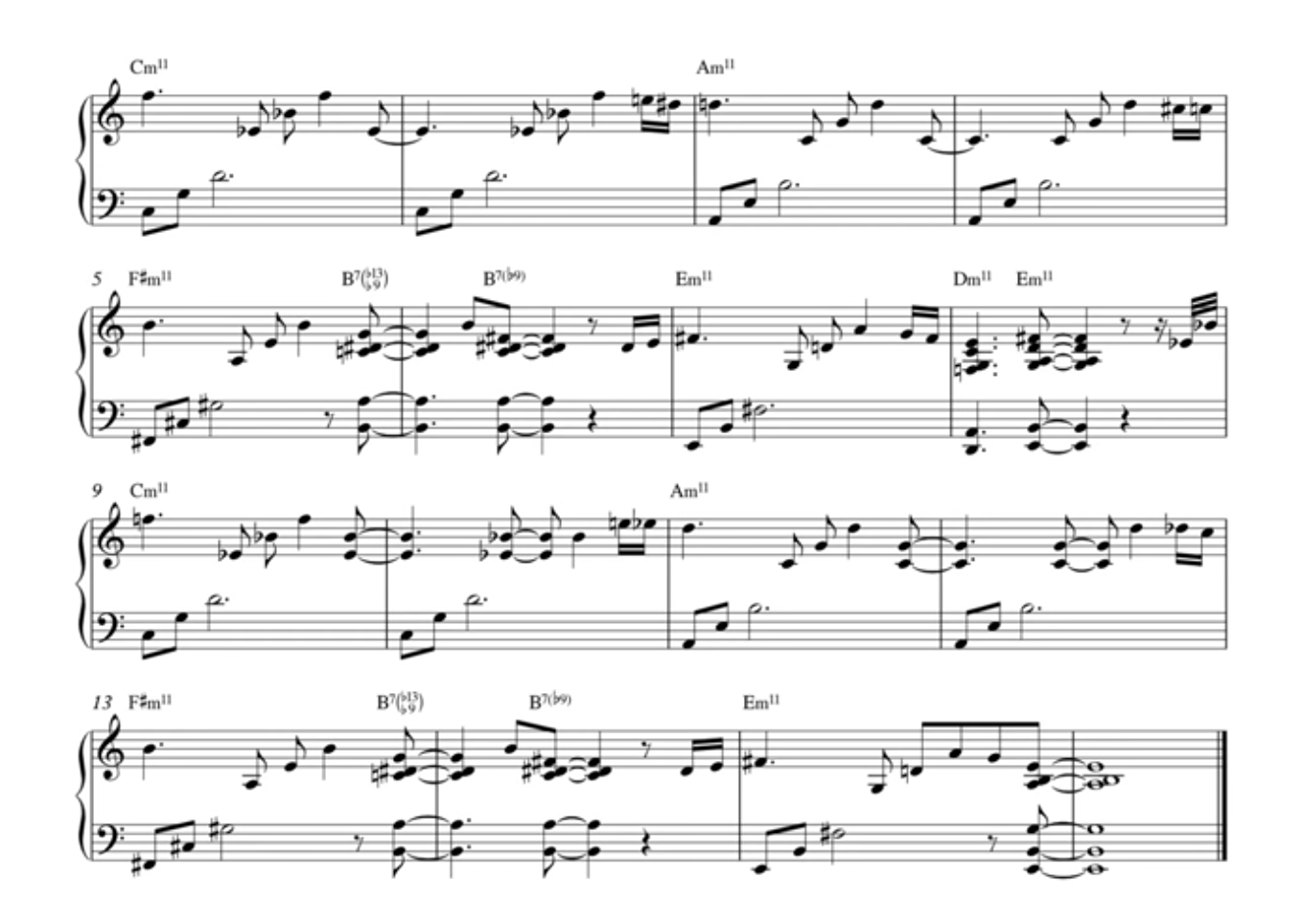
Ep 13. Walking Bass
Given a chord, how could we make it less dumb when playing bass line?
- use arpeggio
- change sequence of the arpeggio (keep the first note rooted)
- add some transition note (for example in a
C-chord, addDbetweenCandE) - add some half note before root note at the first beat (for exmaple in a
C F G Cprogression, add aGbbeforeF, add aF#beforeG - add eighth-note or triplet into the rhythm
Let’s see a combination of the above skills:

Ep 17. How to write a pumping bassline?
There are some tricks we could used when designing a bass line.
- root note on first beat
- root note on each beat
- add some variation on rhythm

- add octave

- add quint

- add seventh

- add other notes which seems well :)

Ep 18. Dominant-11-chord
What’s F/G(named F Over G or F on G)? It’s a root note G and another F chord above it. But it seems ridiculous to noob like me – why it’s reasonable?
The answer is: F/G is actually the G11 chord omitting 3 and 5.
NOTE: G11 = G B D F A C
Take a look at another chord Dm7/G. It’s also a G11 chord omitting 3.
And here comes the question: why we tend to omit 3 in G11? Wiwi gives us an explanation that: B(3) and C(11) seems not that match so we are trying to omit 3
Another question: What’s relation between Dm7/G and G9sus4?
The answer is they are the same.
Dm7/G=G11(omit3)G9sus4=G9sustitude3with4
Ep.19 Dominant-13
Most commonly used Dominant 13 are:
1-3-7-131-3-7-9-131-7-9-11-13
Why omit 5? Same reason as Ep.18 mentioned? 5 and 13 are relatively close? But the note between 3 and 4 are half-tone. Note between 5 and 6 are a whole note.
No idea. Any hint?
Ep.22 3 types of minor mode
There are 3 types of minor scale:
- Natural minor scale
(1-2-3b-4-5-6b-7b)
- Harmonic minor scale
(1-2-3b-4-5-6b-7)
- Melodic minor scale
(1-2-3b-4-5-6-7)for upwards(1-7b-6b-5-4-3-2-1)for downwards
The original Harmonic Minor Scale is invented to resolve the problem that m7 are not able to settled the following Root note comfortably in Natural Minor Scale. For example, in G7 there is a B note which is close to C so a sense of settled are encouraged, but in Gm7, a Bb is introduced and it’s further away from C, which leads to an unwillingness to settled.
The classic musician comes up with an idea that if I could switch back the 7th note from flat to origin, then everything solved.
That’s the origin of Harmonic Minor Scale: (1-2-3b-4-5-6b-7).
And yes, now Gm7(in Harmonic minor scale) become more intended to settle with C, but it brings another (bigger) problem. Now the gap between 6b and 7 is too wide and it sounds more like indian scale! Since it’s not allowed in classical music, musicians then comes up another idea to reset the 6th note so it could connect to 7th nicely. However, if direction reserved, then we don’t have to settle 7b to 1, so 7b could stay as it is, and therefore 6b could remain the same without impacting anything. This is what we call the Melodic Minor Scale, a scale to solve the “6b -> 7” problem. (1-2-3b-4-5-6-7-1-7b-6b-5-4-3b-2-1)
Ep.24-26 I-D-P-L-M-A-L Scales
Aeolian
Scale of Aeolian: 1-2-b3-4-5-b6-b7. To make it sound like Aeolian, we should introduce more b3/b6/b7 in melody.
A typical chord of Aeolian is
mb6.Amb6is the hook ofX filestheme.
Dorian
Scale of Dorian: 1-2-b3-4-5-6-b7
Differences between Dorian & Aeolian is the 6th note. a standard 6 make Dorian more ancient and less sad. See Pars-ley, sage, rose-ma-(ry) and thyme in Scarborough Fair
Phrygian
Scale of Phrygian: 1-b2-b3-4-5-b6-b7
Only half-note between 1 and 2 is a brand of Phrygian (Locrian should be the same, but it’s the only diff between Phrygian and Aeolian).
But according to Wiwi, the variation of Phrygian – Phrygian Dominant (1-b2-3-4-5-b6-b7) is more likely to be used in Flamenco Guitar.
A very interesting things for Phrygian Dominant scale is that both I & II chord are major scales (1-3-5, b2-4-b6)
Lydian
Scale of Lydian: 1-2-3-#4-5-6-7
brand note is 4th. And if we pile the notes in scale every other note, then we could get 1-3-5-7-9-#11-13, which is a Major13#11 chord and it feels dreamy… The most famous example of Lydian is Microsoft Windows 98 Opening chord.
Some other tricks of Lydian is:
- both I & II chord are major scales (1-3-5, 2-#4-6), switching from I to II to make a heroic mood
- combine #4 and 5 to create sense of ridiculous
Mixolydian
Scale of Mixolydian: 1-2-3-4-5-6-b7
It’s mostly used in Blues and Jazz since it fits with 7 chord.
Locrian
Scale of Locrian: 1-b2-b3-4-b5-b6-b7
The only scale that have a flat-5, and the I chord is dim, make the mood of this chord dark. So 5th note is the branding note.
Ep.27 whole tone scale
Scale of whole tone scale: 1-2-3-#4-#5-#6
Ep.28 Secondary Dominant
What’s secondary dominant chord? In chord transition, if we add 5 degree to the target chord and use dominant 7 chord between the transition, it’s still harmonic. The added chord is Secondary Dominant chord.
Examples:
C -> Em=>C -> (B7) -> Em
Here are some other example, and a combination of these tricks.
C -> Am=>C -> (E7) -> AmC -> G=>C -> (D7) -> GC -> Dm=>C -> (A7) -> Dm
Ep.29 Triple Tone
The reason why a V7 chord is likely to settle to I is that V7 contains two tones (7 & 4) which are 3 whole tones away. Such 3 whole tones combination give us an intention to be settled by the next chord.
So if we could find another 3 whole tones, then it could be also the transition chord instead of the V7 chord.
Examples:
* `G7 -> C` => `Db7 -> C`
* `E7 -> Am` => `Bb7 -> Am`
if we compare Db and C / Bb and A, Db is half tone higher than C, so as Bb and C. So it give us another hint that, we could use the 7 chord of a half tone higher note to transit.
See this example below:
Ep.30 More Secondary Dominant
To extend secondary dominant chord, we can add II or IV before it.
Examples:
* `C -> Fmaj7` => `C -> C7 -> Fmaj7` => `C -> Gm7 -> C7 -> Fmaj7` (add II chord (Gm))
* `C2 -> G2` => `C2 -> D7 -> G2` => `C2 -> Am7 -> D7 -> G2`
When transition target chord is minor one, the II chord we add should be Half seventh chord
Examples:
* `C -> Am` => `C -> E7 -> Am` => `C -> Bm7b5 -> E7 -> Am`
Ep. 32-34 Dorian Improvisation / Double Dorian Improvisation / Blue Scale Improvisation
These 3 episodes provide a very helpful way to practise improv skills (and seems it works even for noobie like me). Here are the steps:
- Pick a root note and a scale. For example, C Dorian.
- Determine left hand appregio by choosing 4 to 5 notes in scale. As mentioned,
VIin Dorain is prominant, so we pick1-b3-5-b6. Give it a fix pattern, and repeat during the whole improvisation. - Develop right hand melody. It’s difficult to develop, but we could follow these 3 steps:
- play in scale (upwards and downwards).
- play in scale with eight-note rhythm (upwards and downwards).
- play in scale with eight-note rhythm (random direction).
- play in scale with eight-note rhythm (random).
- play in scale with eight-note rhythm (random + repeat note).
- play in scale with eight-note rhythm (random + repeat note + dual tone + triple tune).
- play in scale with eight-note (and sixteenth-note or triplet) rhythm (random + repeat note + dual tone + triple tune).
- play a famous song in scale.
Ep.41 Major 11
The reason why we usually use #11 instead of 11 in Major scale is that VII note and XI note are triple whole tones, which make it less stable.
Ep.42 Alternations in Dominant Chords
To make chords a little bit diff from the original chord, we could switch 5 and 9 to b5 also #11|#5 also b13|b9|#9 in dominant chords.
So, for a C9 chord, 3*3 of variation could be applied.
C9C9b5C9#5C7b9C7#9C7b5b9C7b5#9C7#5b9C7#5#9
As a relevant topic, Ep.48 Altered Scale are constructed by a Mixolydian scale which replace 5 with two notes b5 and #5, replace 9 with b9 and #9
Ep.42 Minor 11 and Ep.43 for more
For complicate chords, arrangement is important.
Here are arrangements introduced in Ep.42:
- (low)C - bE - G - bB - (high)D - (high)F
- (low)C - bE - F - G - bB - (high)D
the root note are separated from the other notes. the high part make entanglement mood.
Ep.43 introduce some other arrangement. Notes arrangement are much more averaged.
Here are the first one, notes are spread for boarder range:low(C) - low(G) - D - bE - bB - (high)F
Here C-G-D & bE-bB-F share same interval patterns(5 degrees).
This is awesome! Try this score
Another arrangement is omitting 5 and 9 note, make it a Cm7(add11) -> C & bE-bB-F
Ep.44 Borrowed chord
Borrowed chords: A borrowed chord (also called mode mixture and modal interchange) is a chord borrowed from the parallel key (minor or major scale with the same tonic). Borrowed chords are typically used as “color chords”, providing variety through contrasting scale forms, major and the three forms of minor.
Using C Major/Minor as an example:
| Major | C | Dm | Em | F | G | Am | Bdim |
|---|---|---|---|---|---|---|---|
| Minor | Cm | Ddim | E | Fm | Gm | Ab | Bb |
For example, a C major progression C-Am-F-G, all non-rooted chord could be switched to it’s minor version. So here are possible variation of C(add2) - Am11 - FMaj9 - G11:
C(add2) - AbMaj9 - FMaj9 - G11C(add2) - AbMaj9 - Fm9 - G11C(add2) - AbMaj9 - Fm9 - Gm7
Ep.47 Motivic Development
When you are trying to write a melody but there is no idea for what you are going to write. Here are the way:
- think of a [Motif] (https://en.wikipedia.org/wiki/Motif_(music)) : a short musical idea.
- try move upwards/downwards the motif, or reverse the note movement direction.
- change a little bit of tempo